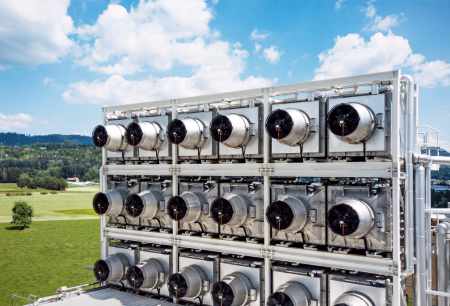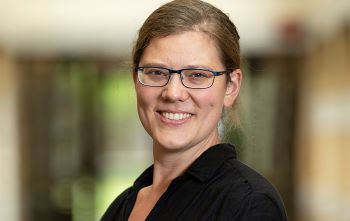Direct air capture technology is no panacea for reducing GHG emissions, say experts
 It sounds like a good idea: capture carbon dioxide emissions directly from the air to reduce CO2 levels in the atmosphere and slow global warming and mitigate climate change.
It sounds like a good idea: capture carbon dioxide emissions directly from the air to reduce CO2 levels in the atmosphere and slow global warming and mitigate climate change.
But direct air capture (DAC) technology will not be a “silver bullet” for reducing greenhouse gas emissions to prevent catastrophic global warming, say experts in the technology.
DAC will likely remain the most expensive way to cut GHG emissions and will probably require regulating by government rather than uncontrolled deployment in a profit-driven market, they told a webinar, “What Role Does Direct Air Capture Play in Achieving Net Zero,” hosted by the Transition Accelerator.
The pan-Canadian charitable organization works to identify and advance pathways that lead to net-zero GHG emissions by 2050.
Even with DAC and other carbon removal technologies, companies will still need to reduces emissions at source at their industrial facilities in order to meet countries’ targets and stabilize the climate, panelists told the webinar.
 “There is no ‘silver bullet’ for getting to net-zero greenhouse gas emissions. Rather, it is more like ‘silver buckshot,’ and direct air capture is one of the ‘pellets’ in the buckshot,” webinar moderator Dr. David Layzell, PhD (photo at left), energy systems architect at the Transition Accelerator, said in an email to Research Money.
“There is no ‘silver bullet’ for getting to net-zero greenhouse gas emissions. Rather, it is more like ‘silver buckshot,’ and direct air capture is one of the ‘pellets’ in the buckshot,” webinar moderator Dr. David Layzell, PhD (photo at left), energy systems architect at the Transition Accelerator, said in an email to Research Money.
The least-cost, and most impactful solution is to not put GHGs into the atmosphere in the first place, by shifting to zero-emission energy carriers like electricity, biofuels and hydrogen, or by better managing methane emissions, he said.
But even if fully deployed, these approaches can only achieve GHG reductions of about 80 per cent or 90 per cent, Layzell said. “So to get all the way to net-zero, we will need to deploy atmospheric carbon removal technologies, and this is where DAC fits in.”
 Removing CO2 from the atmosphere through DAC and other technologies “is not going to be an insurance policy in case sustained decarbonization and emissions reduction fail,” said Silvan Aeschlimann (photo at right), manager carbon removal initiative at Colorado-based Rocky Mountain Institute. “It’s a complementary tool that can only be successful if we achieve sustained emissions reduction.”
Removing CO2 from the atmosphere through DAC and other technologies “is not going to be an insurance policy in case sustained decarbonization and emissions reduction fail,” said Silvan Aeschlimann (photo at right), manager carbon removal initiative at Colorado-based Rocky Mountain Institute. “It’s a complementary tool that can only be successful if we achieve sustained emissions reduction.”
Global GHG emissions are currently about 50 billion tonnes of carbon dioxide equivalent per year, about three-quarters of which are associated with the product and use of energy. To avoid the most severe impacts of climate change, the scientific consensus is that net-zero GHG emissions must by achieved by mid-century – which is Canada’s target.
However, even if every country met its commitment to reduce GHGs, “stabilization of global climate is likely to require implementation of carbon removal technologies even after we meet net zero, to make us negative emissions into the future,” Layzell said.
Direct air capture technology is one way to remove carbon. DAC uses specialized chemicals or materials to bind atmospheric CO2 directly from ambient air, and then permanently store the CO2 underground or use it to make something useful, such as synthetic fuel.
Another way of removing carbon is to build carbon stocks in forests (e.g. by planting trees), agricultural soils, wetlands and in the ocean. Another approach is to convert sustainability growing biomass to fuel or electricity, while capturing and storing the CO2 byproduct in geological formations.
 “I really see DAC as a fundamental technology in terms of us addressing climate,” said Donald Addu (photo at left), senior manager, strategic partnerships at DAC developer Climeworks, based in Switzerland.
“I really see DAC as a fundamental technology in terms of us addressing climate,” said Donald Addu (photo at left), senior manager, strategic partnerships at DAC developer Climeworks, based in Switzerland.
The benefits of DAC include very little land being required to capture a very large amount of CO2, he said. Also, unlike some other carbon removal technologies, the amount of CO2 removed from the atmosphere can be precisely measured and verified.
“This will be important for policies and regulations that move companies toward their net-zero goals and ultimately getting that CO2 out of the air,” Addu said.
Layzell noted that direct air capture has the advantage that it can be deployed at scale wherever there’s access to both low-cost, low-carbon electricity and the geology needed for permanent storage of the CO2.
 DAC certainly is capable of removing CO2, but its implementation may not always result in reduced GHG emissions, said Emily Grubert (photo at right), associate professor of sustainable energy policy at the University of Notre Dame in Indiana.
DAC certainly is capable of removing CO2, but its implementation may not always result in reduced GHG emissions, said Emily Grubert (photo at right), associate professor of sustainable energy policy at the University of Notre Dame in Indiana.
DAC technology requires a lot of energy input. If that power comes from emissions-intensive sources, such as fossil fuel-based electricity, the DAC facility isn’t going to be removing net emissions from the atmosphere, she said.
Also, using DAC to make jet fuel, for example, may avoid some CO2 emissions, but it doesn’t remove net carbon because CO2 is still going to be released to the atmosphere, Grubert said. “A lot of the questions moving forward is what that [DAC] capability will look like.”
Cost of DAC technology is one of the biggest challenges
The current price of removing carbon with DAC that Climeworks offers on its website is $1,200 per tonne, and even the company’s large corporate customers pay in the triple digits per tonne, Addu said.
In comparison, the current carbon price in Canada is $65 per tonne and is scheduled to increase to $170 per tonne by 2030.
Even at the rock-bottom price of three cents per kilowatt-hour for electricity supplied by wind energy, DAC would still cost more than $60 per tonne of CO2 captured, Grubert noted. “Direct air capture is probably always going to be expensive.”
Addu said Climeworks expects the cost of DAC to decline as the technology gets to economies of scale and efficiency. Market pressure will change the artificially low pricing of carbon that’s currently around several dollars per tonne, he said.
Addu pointed to a report by Boston Consulting Group that found the publicly announced demand for carbon removal is 1.3 billion tonnes, while the actual carbon removal projects announced amount to only 0.3 billion tonnes.
“So there’s a gigatonne supply gap. If we’re thinking about this in terms of a commodity, in any commodities market that differential between supply and demand would send [carbon] prices soaring,” Addu said.
Aeschlimann said the potential market for DAC is still so uncertain that no one can say what the technology will cost. “The only thing we know is it’s pretty much going to be more expensive than most people think.”
A study by the Rocky Mountain Institute that analyzed all available public cost data on any DAC solutions concluded that their costs realistically might decline to about $250 to $300 per tonne. That is several orders of cost greater than other carbon removal technologies, including
- removing carbon by planting trees and preventing deforestation (the most recent research indicates forests hold, on average, 30 per cent more carbon than what countries have previously reported)
- accelerating the natural ability of some minerals to absorb CO2 from the atmosphere
- using biomass energy extraction coupled with carbon capture and storage.
Nevertheless, given DAC’s advantages in being verifiable and controllable, “we will pretty much need it in our portfolio of solutions, even if it remains more expensive than other carbon dioxide removal solutions,” Aeschlimann said.
In Canada, the federal government offers an incentive tax credit of 60 per cent for investment in equipment to capture CO2 in direct air capture projects, and 50 per cent for equipment to capture CO2 in all other CCUS projects. Ottawa also offers an incentive of 37.5 per cent for investment in equipment for CO2 transportation, storage and use.
The Alberta government offers grant funding of up to 12 per cent of a project’s eligible capital costs incurred on new carbon capture, utilization and storage projects.
However, more generous incentives offered by the U.S. Inflation Reduction Act is one reason why one of Canada’s leading DAC developers, Squamish, B.C.-based Carbon Engineering, is building its first commercial-scale plant in Texas. Occidental Petroleum bought Carbon Engineering in August for more than US$1.1 billion.
DAC faces scalability challenge
Another big challenge for DAC is whether the technology will be able to scale up sufficiently to have a meaningful impact on reducing GHG emissions by 2050.
“The ability for us to scale and scale quickly is essential,” said Addu of Climeworks.
Climeworks’ DAC facility in Iceland – operated on electricity from a geothermal source and currently the largest in the world – has the capacity to capture 4,000 tonnes of CO2 per year. The company is building a new plant in Iceland that will capture 40,000 tonnes per year when it comes online next year.
In comparison, the Intergovernmental Panel on Climate Change estimated that about 20 billion tonnes of CO2 will need to be removed from the atmosphere by 2050 in order to limit global warming to around 1.5º C.
All of today’s carbon removal approaches capture only a tiny fraction of that: around 2 billion tonnes of CO2 annually, according to recent research. Nearly all of this removal is accomplished through long-standing, nature-based strategies such as replanting forests, rather than via advanced technologies.
Charles Harvey, a professor of civil and environmental engineering at MIT, said in an article on MIT’s website that the energy demands of direct air capture are so great that “cancelling out” humanity’s GHG emissions using DAC would take more energy than we’re getting from burning fossil fuels in the first place. Any money spent on DAC would be better spent on building out renewable energy sources, he said.
Addu and Aeschlimann agreed that it is technologically possible for DAC to scale up to 1 billion tonnes of CO2 removal per year by 2050 – which would still leave a huge gap in the amount of carbon that needs to be removed from the atmosphere. And even that can only happen if companies and government invest in DAC immediately, not wait until 2050, they said.
DAC technology also could turn out to be an excuse for heavy industrial emitters to keep on emitting, Aeschlimann said. “When corporations with their targets claim they want to get to net zero, you must make sure they remove all emissions that stem from fossil fuels with permanent carbon dioxide removal solutions.”
Potential problems with how DAC would be used
DAC’s high cost and intensive energy usage makes it a limited resource, Grubert said. So if government incentives are used to offset DAC’s costs, it raises questions of how and where DAC should be deployed.
For example, DAC used by multinational oil companies to get to net-zero oil production (which would lead to more downstream GHG emissions) is a different scenario from using the technology to address the remaining few difficult-to-abate industrial emissions, such as nitrous oxide emissions in the agricultural sector remaining even after using precision, low-GHG fertilizers.
“We need to think about having some sort of societally beneficial method of how you allocate carbon dioxide removal and direct air capture [technologies],” Grubert said.
Grubert said she thinks controlling DAC’s deployment through government regulations and/or publicly owned utilities, and supporting the technology through public taxes, will be required to ensure DAC is used for maximum societal benefits. “I think we are about to make a really big mistake if we move into an unconstrained, market-driven setting with carbon dioxide removal [technologies].”
"What we’re seeing especially in the U.S. is a huge amount of public funding going to these things without a lot of public control,” Grubert added.
“Without really thinking carefully about how much carbon dioxide removal we need, how much DAC we need specifically – and assuming that people are going to be paying for this collectively – how do we make sure that we’re actually devoting this scarce resource to the things that we need it for, as opposed to things that are randomly coming out of various actors purchasing it?”
Aeschlimann agreed that having a voluntary market is probably not going to be sufficient, given how enormous the carbon removal problem is. Advanced economies in the Global North, which historically have emitted much more GHGs than the Global South, should be paying the costs of carbon dioxide removal including with DAC, he said.
“In the end game, this [carbon removal technology] will have to be integrated to a certain degree into a compliance market,” he added.
Addu said a well-structured, steadily increasing, revenue-neutral carbon tax on upstream emissions – which is what Canada has – is an effective way to incentivize investment in DAC. Other approaches include direct government procurement, market purchases, and other types of incentives and subsidies.
Environmental impacts, community acceptance are issues
Deploying DAC also raises the possibility of “unintended consequences.” Nearly four years ago in the rural Mississippi Delta town of Satartia, a CO2 pipeline owned by a Texas-based company ruptured. The resulting leak released more than 31,000 barrels of CO2 that prompted the evacuation of more than 300 people, with more than 40 requiring treatment in hospital.
Potential environmental impacts of DAC are another concern. It takes about five tonnes of water to capture one tonne of CO2 using a liquid solvent, which DAC companies such as Carbon Engineering do, Aeschlimann said. Using such a DAC technology in a drought-prone area wouldn’t be a good idea.
“If you want to minimize unintended consequences, you basically have to use the specific technologies in a place where they hurt least and where there are cost benefits,” he said.
Grubert said there’s also a concern about communities’ willingness to accept direct air capture facilities by telling them that the technology is for removing carbon dioxide from the atmosphere to help restore the climate, when in fact DAC will be used to produce and sell net-zero oil. “We’re making promises to people that are not necessarily being fulfilled.”
Aeschilmann said the importance of engaging communities can’t be underestimated, including asking whether they want DAC and other carbon removal facilities and ensuring these communities receive tangible benefits.
Addu said Climeworks is already doing community engagement now in Louisiana where the company plans to build a DAC facility. The company’s goal also is to limit any CO2 pipeline required for a DAC project to a maximum 10 kilometres long he said, noting that the pipeline for the Louisiana facility will be nine km long.
Panelists agreed that this decade is crucial for making decisions on how and when DAC will be used and who will pay for it.
“We need to vote for this technology,” Addu said. “In order for us to scale, we need a market for it. If nobody buys it, we’re not going to make it.”
Layzell said he thinks DAC has an important, but minor role to play in the transition to net-zero. “Of course, society must figure out how to pay for its high cost. At the very least, that points to the need to put a price on carbon pollution, and focus much of our attention on the other [ways to reduce emissions].”
R$
Events For Leaders in
Science, Tech, Innovation, and Policy
Discuss and learn from those in the know at our virtual and in-person events.
See Upcoming Events
You have 0 free articles remaining.
Don't miss out - start your free trial today.
Start your FREE trial Already a member? Log in
By using this website, you agree to our use of cookies. We use cookies to provide you with a great experience and to help our website run effectively in accordance with our Privacy Policy and Terms of Service.




